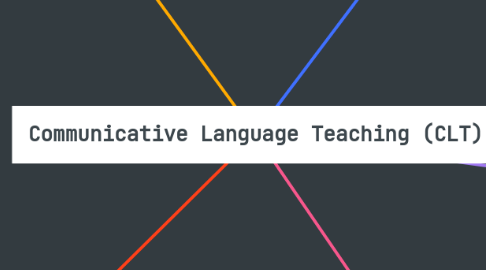
1. 2. Key Techniques
1.1. 📌Role-plays
1.1.1. – Simulating real-world interactions (e.g., ordering food, job interviews)
1.2. 📌Information gap activities
1.2.1. – Students exchange missing information to complete a task
1.3. 📌Group discussions
1.3.1. – Encouraging debates and conversations on various topics
1.4. 📌Problem-solving tasks
1.4.1. – Collaborative activities that require critical thinking and negotiation
1.5. 📌Authentic materials
1.5.1. – Using real-life resources (e.g., newspapers, videos, menus, podcasts)
1.6. 📌Storytelling & Narratives
1.6.1. – Students create and share stories, enhancing speaking skills
2. 6. Challenges
2.1. 4. Student's Role
2.1.1. 🗣️ Active participant
2.1.1.1. – Engages in communication rather than passively listening
2.1.2. 🤝 Collaborator
2.1.2.1. – Works with peers to complete tasks and develop language skills
2.1.3. 🧠 Problem solver
2.1.3.1. Uses language as a tool to navigate real-life challenges
2.1.4. 🎭 Risk taker
2.1.4.1. – Learns from mistakes and experiments with new expressions
2.2. ⚠️Grammar may be neglected
2.2.1. – Focus on fluency can lead to weaker grammatical accuracy
2.3. ⚠️Requires trained teachers
2.3.1. – Teachers need to be skilled in facilitating communication
2.4. ⚠️Large class sizes can be problematic
2.4.1. – Difficult to manage interactive activities with many students
2.5. ⚠️Assessment difficulties
2.5.1. – Measuring communicative competence is more complex than testing grammar
2.6. ⚠️ Cultural adaptation
2.6.1. – Some learners may be uncomfortable with interactive activities
3. 1. Principles of CLT
3.1. ✅Focus on communication
3.1.1. – Learning a language by using it in real-life situations
3.2. ✅Meaning over form
3.2.1. – Understanding and expressing meaning is more important than perfect grammar.
3.3. ✅Interaction-driven learning
3.3.1. – Language is learned through speaking, listening, and interacting with others.
3.4. ✅Task-based activities
3.4.1. – Learning happens through meaningful tasks rather than rote memorization
3.5. ✅Fluency over accuracy
3.5.1. – Encouraging students to communicate ideas without fear of making mistakes
4. 3. Teacher's Role
4.1. 👨🏫 Facilitator
4.1.1. – Creates opportunities for communication rather than just delivering content
4.2. 👨🏫 Guide
4.2.1. – Provides feedback and helps students refine their communication skills
4.3. 💡 Motivator
4.3.1. – Encourages students to express themselves freely
4.4. 📋 Organizer
4.4.1. – Designs interactive and meaningful learning activities
5. 5. Advantages
5.1. ✔️Enhances fluency
5.1.1. – Students become more confident in speaking and listening
5.2. ✔️Encourages real-life communication
5.2.1. – Prepares learners for practical situations
5.3. ✔️Increases motivation
5.3.1. – Interactive methods make learning engaging and enjoyable
5.4. ✔️Develops critical thinking
5.4.1. – Encourages problem-solving and decision-making
5.5. ✔️ Personalized learning
5.5.1. – Allows students to express their thoughts and ideas
